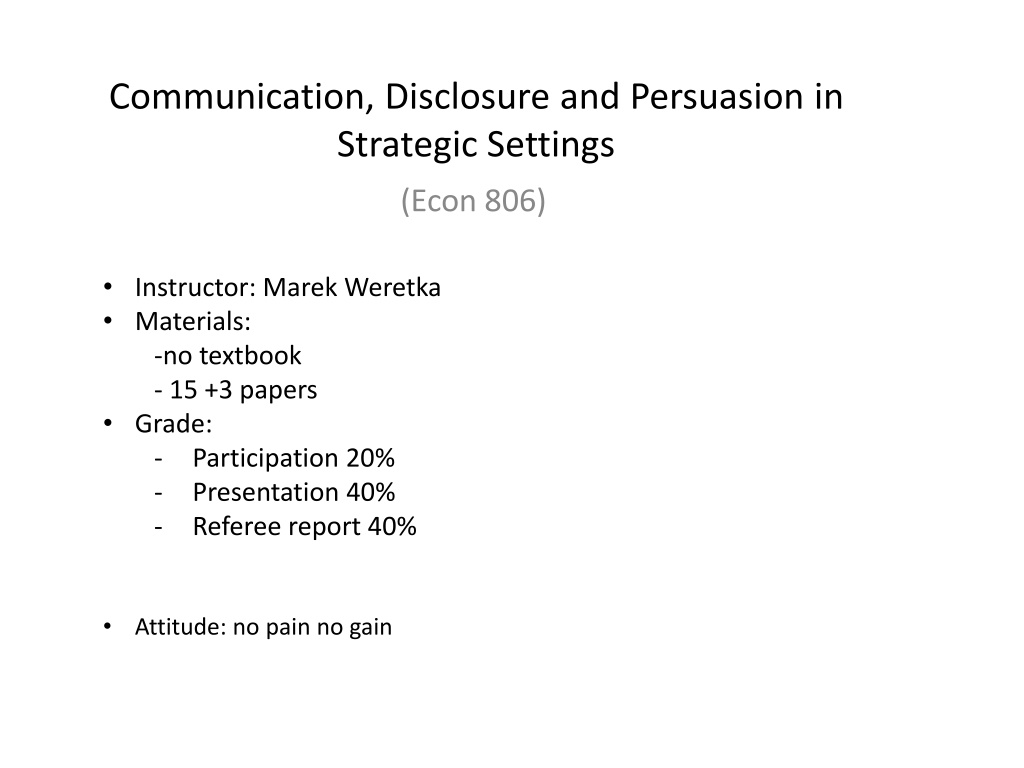
Strategic Communication and Information in Economics
Explore the dynamics of communication, persuasion, and disclosure in strategic settings within the context of Economics. Dive into the Sender-Receiver model, various games, and applications across different fields.
Download Presentation

Please find below an Image/Link to download the presentation.
The content on the website is provided AS IS for your information and personal use only. It may not be sold, licensed, or shared on other websites without obtaining consent from the author. If you encounter any issues during the download, it is possible that the publisher has removed the file from their server.
You are allowed to download the files provided on this website for personal or commercial use, subject to the condition that they are used lawfully. All files are the property of their respective owners.
The content on the website is provided AS IS for your information and personal use only. It may not be sold, licensed, or shared on other websites without obtaining consent from the author.
E N D
Presentation Transcript
Communication, Disclosure and Persuasion in Strategic Settings (Econ 806) Instructor: Marek Weretka Materials: -no textbook - 15 +3 papers Grade: - Participation 20% - Presentation 40% - Referee report 40% Attitude: no pain no gain
Important surveys Giving and Receiving Advice Sobel, 2013 What the Seller Won t Tell You: Persuasion and Disclosure in Markets Paul Milgrom, 2008 Static Information Design Bergmann and Morris, 2017
Questions Why do we talk? When should we conceal our private information? When should we be skeptical about other s advice? Can communication solve problem of asymmetric information? Which institutions foster effective communication? Can a rational (Bayesian) agent be persuaded/manipulated? If yes how? Can a population of rational agents be persuaded? How? Can a rational agent prevent manipulation? Can divergence of opinions improve communication? All these questions can be answered within a Sender-Receiver model
Sender-Receiver (S-R) Model Two (types of) agents: - Sender S (expert, informed agent) - Receiver R (decision maker, uninformed agent) Timing and actions: - S observes state , sends message - R observes message , choses action Preferences: Depending on a state and message set, or (lack of) commitment this model becomes a Cheap Talk, Mediation, Arbitration, Disclosure or Bayesian Persuasion game These games offer alternative insights regarding strategic communication.
Applications Industrial Organization Auction Theory Finance Political science Economics of Media Organizational Science Zoology Linguistics (Pragmatics)
Outline of the Course Cheap talk (no commitment, non-verifiable messages) - Basic model (Crawford and Sobel, 1982) - Multidimensional state space (Chakraborty and Harbaugh 2010) - Many Senders (Krishna and Morgan 2001, Battaglini 2002, Ambrus 2010) Disclosure games (verifiable messages) - Basic game (Grossman 81, Milgrom 1981, 2008) - Partly informed senders (Shin 2003, Glazer and Rubinstein 2004, 2006,) - Disclosure with behavioral biases (Dziuda 2011) Institutions (receiver s commitment) - Mediation (Blume, Board and Kawamura 2007, Goltsman, at. Al.2009) - Arbitration (Goltsman, at. Al.2009)
Outline of the Course Bayesian Persuasion (sender s commitment) - Basic game (Kamienica and Gentzkow, 2011) - Many senders (Kamienica and Gentzkow, 2016a, 2016b ) - Many receivers (Bergmann and Morris, 2017) - Application (Bergmann Brooks and Morris, 2015) Costly acquisition of Information by a Sender - Divergent priors (Che and Kartik 2009) Students presentations
Outline of the Course Presentations (suggested papers) 1. Kendall et al. How do Voters Respond to Information? (AER 2015) 2. Malmendier and Shanthikumar Are Small Investors Naive about Incentives (JFE 2007) 3. Chiang and Knight Media Bias and Influence (ReStud 2011) 4. Gentzkow and Shaprio 2010 What Drives Media Slant? (Ecma 2010) 5. Hong and Kacperczyk 2010 Competition and Bias (QJE 2010) 6. Ferraz and Finan 2008 Exposing Corrupt Politicians (QJE 2008)
Basic Cheap Talk Game Basic cheap talk (Crawford and Sobel, 1982, Green and Stocky, 2007) - Sender-Receiver, no commitment, unrestricted message space - State space , action space , preferences: - Solution concept: PBN equilibrium Key insights: - Existence of PBN? Bubbling equilibrium always exists - Partition (partly revealing) equilibrium under strong conditions - Ex ante welfare of S and R improves with equilibrium informativeness Key insight: cheap talk effective not very effective, requires two conditions - preferences of S and R strongly aligned - preferences of different sender types in conflict
Cheap Talk c.d. Multidimensional state space (Chakraborty and Harbaugh 2006, 2010) - Example 1: recommendation letters for Ph.D. students - Example 2: biased newspaper Two insights: - shared interests of S and R are very common - Ex ante S welfare may decrease in equilibrium informativeness ``Competition among many senders (Battaglini 2002) - Extreme action as a punishment (lack of robustness) - Full revelation in ``robust without punishment Key insight: competition fosters communication
Disclosure Game (Verifiable messages) Basic disclosure game (Milgrom 1981, 2008) - S-R model with message space - Verifiable messages: - Solution concept: PBN equilibrium Key insights: - unraveling of information from the top - extreme skepticism of R Unraveling of information may fail if - S does not have have full evidence (or has to acquire it) - Behavioral biases
Institutions (commitment of R) Objective: ex ante welfare of R (quadratic preferences =S) ``Broken phone paradox (Blume, Board and Kawamura 2007) Mediation: - Third party collects information from S and sends a signal to R - Optimal mediation improves over one round of cheap talk - ``Broken phone implements optimal mediation rule Arbitration - Third party collects information, makes binding recommendation to R - Optimal arbitration rule delegation rule with cap - Very effective communication
Bayesian persuasion (commitment of S) Sender ex ante commits to strategy Objective: ex ante welfare of S Interpretation: literal or metaphorical information designer Key insights - S selectively obfuscates information (outcome manipulation) - Less power to manipulate if R more informed (more precise prior) - Many R: Private vs public signals Technical insights: - Concavification of value function (S-R model) - Two stage procedure
